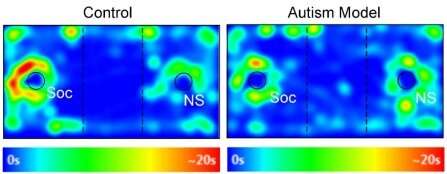Powerful drug discovery protocol for autism is accelerating the development of new treatments


A sensitive and reliable new protocol for assessing social deficits in animal models of autism and certain psychiatric conditions is expediting the search for effective treatments. Developed by University at Buffalo researchers, the new protocol is described in a paper published today in Nature Protocols.
“The protocol we developed is facilitating studies on social behaviors and mental disorders related to social impairment,” said Zhen Yan, Ph.D., SUNY Distinguished Professor in the Department of Physiology and Biophysics in the Jacobs School of Medicine and Biomedical Sciences at UB and senior author on the paper.
She noted that a clinical trial for an autism treatment now underway by Oryzon, the European biopharmaceutical company, is, in part, based on preclinical studies conducted at UB with the protocol. That trial is focused on a form of autism called Phelan-McDermid Syndrome, which results from a single genetic deficiency in a gene called Shank3. The UB researchers have significantly contributed to the understanding of how that genetic mutation causes the social deficits.
Determining the effectiveness of a potential treatment for brain disorders cannot be done the way it is for many other diseases: by checking a biomarker in the blood or measuring tumor size and spread. The only way to determine how effective potential therapies for autism might be is to observe behavioral changes in preclinical models.
No biomarkers
“We don’t have a biomarker for autism,” said Yan. “Social deficits are the core symptom.”
That’s why a sensitive and reliable protocol for measuring social deficits is so crucial to finding new autism treatments.
“To find out whether a therapeutic strategy works or not, outcome measurements rely on behavior,” Yan said. “So a social preference protocol is a critical ingredient in determining the effectiveness of potential therapies in brain diseases like autism and certain mental disorders.”
Social preference protocols for autism and similar conditions are based on the fact that normal animals will spend much more time interacting with a so-called social object, meaning another animal, than they will with a non-social, inanimate object, such as a block of wood.
“In a mouse model of autism, this social preference will be significantly diminished,” Yan said.
Assessing behavior changes
But assessing behavior changes in mouse models of autism isn’t easy. A widely used method for social preference has been a simple three-chamber assay, in which the test mouse is first habituated to an empty three-chamber apparatus. Then, one empty cup is placed in one side chamber, and another cup containing a mouse is placed in the other side chamber, and the amount of time spent interacting with either stimulus is recorded.
“That type of test had an intrinsic bias,” Yan explained. “The social stimulus, which contains both a novel social stimulus (mouse) and a novel non-social stimulus (cup), is more salient than the non-social stimulus (cup alone), which may mask the presence of social preference deficits in autism models.”
Similar protocols have produced inconsistent results, Yan said.
The protocol developed at UB is different for several reasons. The test mouse is first habituated to a three-chamber apparatus containing two empty cups in side chambers. The animal then is introduced to two identical inanimate objects (e.g. paper balls) placed within the cups. In the test phase, a social stimulus (mouse) is introduced under one cup and a novel non-social stimulus (e.g. wooden block) is placed under the other cup. The preference between social and non-social stimuli under conditions of equal salience is assessed.
Tests by Yan and her colleagues have demonstrated that this protocol successfully detects social preference deficits in several autism mouse models, and outperforms the widely used method that differs in animal habituation and testing.
“You need a measurement of the phenotype that is both sensitive and robust, and this protocol is both,” said Yan.
Source: Read Full Article